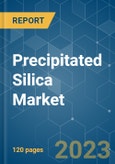The demand for precipitated silica surged due to the growth of the automobile tire industry across the world. The increasing usage of high-quality precipitated silica is expected to drive the market during the forecast period.
On the flip side, stringent environmental regulations are expected to hinder the growth of the market.
The rising demand for precipitated silica from rubber, agrochemicals, and oral care industries is projected to act as an opportunity for the market in the future.
The Asia-Pacific region is expected to dominate the market and is also likely to witness the highest CAGR during the forecast period.
Precipitated Silica Market Trends
Automobile Industry is Anticipated to Dominate the Market
Increasing utilization of precipitated silica in tires to enhance tire tread wear resistance and adhesion is the major factor driving the market growth.Tire manufacturers largely use precipitated silica to provide performance in wet weather conditions. It is utilized to give flexibility by accumulating low heat. In tires, precipitated silica improves physical & dynamic properties such as tensile strength, abrasion resistance, tear resistance, wet grip, etc.
The production of automobiles is increasing all around the globe. According to OICA, ~ 80 million motor vehicles were produced all around the globe in 2021, which is ~3% more than in 2020. Thus, rising automobile production increases the demand for tires, which in turn increases the consumption of precipitated silica.
China contributes to more than 40% of global tire production. In 2021, the tire production volume reached almost 900 million units, a significant growth from 807.47 million units in 2020.
United States represents one of the largest and most advanced tire markets in the world. According to United States Tire Manufacturers Association (USTMA), total tire shipments in United States reached more than 336 million units in 2021, up from 303.2 million units in 2020.
Countries such as Japan, Europe, United States, South Korea, and Brazil have enacted, or are in the process of developing, new regulations requiring labels for tires. In order to comply with these new regulations, a technological change is required in place of carbon black, which can be possible by highly dispersible precipitated silica.
All the aforementioned factors are expected to drive the global market during the forecast period.
Asia-Pacific Region to Dominate the Market
The Asia-Pacific region is expected to dominate the market. China and India are among the major and fastest growing markets for precipitated silica market in the region.According to the China Rubber Industry Association (CRIA), China is projected to produce 704 million tires per year by 2025, including 527 million passenger radial tires, 148 million truck/bus radial tires, 29 million bias truck tires, 20,000 extra-large industrial tires, 12 million agricultural tires, and 54,000 aircraft tires. In addition, China will produce 120.7 million motorcycle tires and 420 million bicycle tires annually by 2025.
At present, India has the world's fifth-largest passenger car market, the world's largest motorcycle market, and the world's third-largest commercial vehicle market. On Indian highways, there are more than 250 million scooters/motorcycles, 40 million cars, and 10 million commercial vehicles. This huge fleet can be translated into an immense demand for precipitated silica in tire applications.
Furthermore, in the agriculture sector, precipitated silica is used in pesticides, insecticides, and herbicides as the particle size is too fine, and as an anti-caking agent for powders due to its high adsorptive power.
Agriculture is the primary source of livelihood for about ~58% of India's population. According to the World Trade Centre, India can be among the top five exporters of agro commodities by shifting its focus on cultivation and effectively handholding farmers. The total agricultural and allied products exports stood at USD 41.25 billion in FY21.
China, a big agricultural country endowed with rich agricultural resources, has a long history of farming and the tradition of intensive cultivation, as well as a huge rural population.
Due to all the above-mentioned factors, the Asia-Pacific region is expected to see an increase in demand during the forecast period.
Precipitated Silica Industry Overview
The precipitated silica market is consolidated in nature. Some of the major players in the market include (not in any particular order) Evonik Industries AG, Solvay, PPG Industries Inc., Madhu Silica Pvt. Ltd., and QUECHEN, among others.Additional Benefits:
- The market estimate (ME) sheet in Excel format
- 3 months of analyst support
This product will be delivered within 2 business days.
Table of Contents
Companies Mentioned (Partial List)
A selection of companies mentioned in this report includes, but is not limited to:
- AMS Applied Material Solutions
- Anten Chemical Co.,Ltd.
- Covia Holdings LLC.
- Denka Company Limited
- Evonik Industries AG
- Madhu Silica Pvt. Ltd.
- PPG Industries Inc.
- QUECHEN
- Solvay
- Tosoh Silica Corporation
- W. R. Grace & Co.-Conn.








